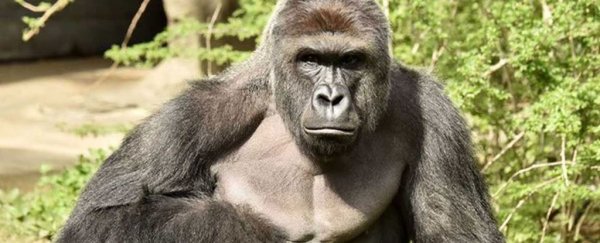While the world is still coming to terms with the tragic shooting of Harambe the male gorilla at the Cincinnati Zoo on Saturday, officials have announced that the endangered silverback will be able to live on genetically, after they collected a sample of his sperm shortly after his death.
Reproductive biologists from the zoo's Centre for Conservation and Research of Endangered Wildlife are reported to have collected sperm samples from Harambe after the shooting took place.
The news raises the possibility that one day the gorilla, who at 17 years of age was too young to breed, could one day still father offspring via artificial insemination or other assisted reproduction programs.
"There's a future," the zoo's director Thane Maynard announced to the media this week. "It's not the end of his gene pool."
But just because Harambe's frozen sperm will be preserved does not necessarily mean that the sample will be used to create life any time soon. According to representatives of the US body that controls breeding of zoo animals, Harambe's sperm is more likely to be collected for scientific purposes than to continue his bloodline in the here and now.
"Currently, it's not anything we would use for reproduction," biologist Kristen Lukas, who chairs the Association of Zoos and Aquariums' Gorilla Species Survival Plan, told Laila Kearney at Reuters. "It will be banked and just stored for future use or for research studies."
Harambe's death on Saturday caused a huge amount of controversy after the gorilla was shot when a four-year-old boy fell into his enclosure. The boy survived the incident and has since been released from hospital, but many criticised the shooting and argued that alternatives to a lethal response should have been attempted.
Critics of the killing argue that Harambe was not at fault for the incident and some claim it's unclear whether he was posing a direct threat to the child, and may have even been attempting to protect the boy from the screaming crowd watching on. But the zoo has defended its actions.
"We are heartbroken about losing Harambe, but a child's life was in danger and a quick decision had to be made by our Dangerous Animal Response Team," Maynard said in a statement.
"It is important to note that with the child still in the exhibit, tranquilising the 450-pound (204-kg) gorilla was not an option. Tranquilisers do not take effect for several minutes and the child was in imminent danger. On top of that, the impact from the dart could agitate the animal and cause the situation to get much worse."
While the controversy will wage on, at least some might find consolation in the knowledge that Harambe's sperm – to be stored in a "frozen zoo" of liquid nitrogen that could keep it viable for hundreds of years – might help to protect his endangered species in the future, even though sadly we couldn't protect him.
In a "dire situation", such as a new disease threatening the remaining 175,000 gorillas in the wild, "we would then be able to continue the population," Lukas told Reuters.
